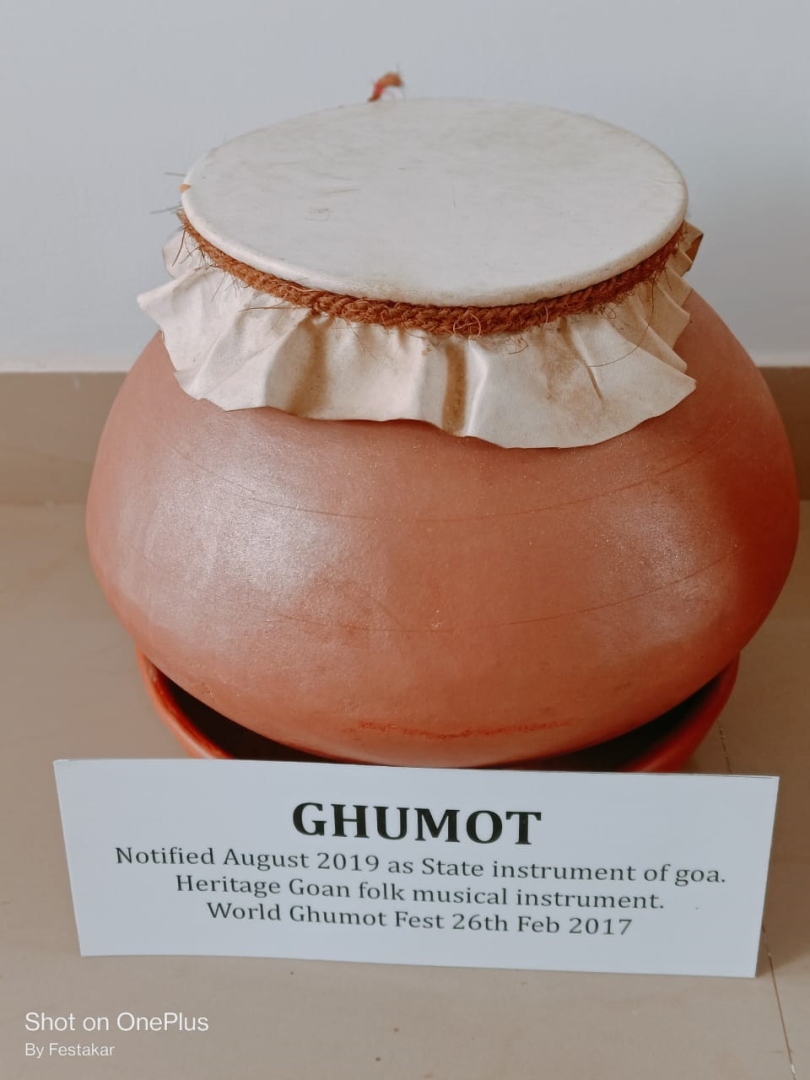
When the Monitor Lizard (Varanus bengalensis) was not an endangered species, and the number of ghumott players was small, the use of its hide as the diaphragm of this unique percussion instrument was not an issue. The ghumott suffered collateral damage when the Monitor Lizard became endangered and the use of its hide was banned worldwide, including India. It appeared to be the end of the road but, in reality, we had arrived at ‘the road not taken’ as if by poetic justice. As we say in Konkani, ‘Zaina oxem kai na,’ nothing is impossible.
There is a long history to the ghumott, steeped in the tradition, culture and ethos of Goa and the rest of the Konkan. The issue is also mired in the ‘biodiversity’ debate because the greed of men has driven many plant and animal species to extinction. The Monitor Lizard is known as ‘garr’ in Konkani and ‘ghorpad’ in Marathi. An entire clan of Marathas adopted the surname of ‘Ghorpade’. The valour of Tanaji is intricately linked with this reptile. In fact, the Maratha history is incomplete without a mention of the ‘ghorpad’. Herpetologist Nirmal Kulkarni has done a project on this reptile and its conservation, including the use of alternative hide for the ghumott.
Desperate situations need desperate solutions. Ashley Fernandes, then a young lad in his teens, was commissioned to find the sacrificial goat, almost literally. He had taken up a project to find an alternative hide to make the ghumott sound as near to the ‘original’ version with the monitor lizard hide, which was no longer an option. It was a long and strenuous effort, with a lot of criticism by the ‘traditionalists’, but it worked!
It is not without reason that we have this maxim, ‘Success has a thousand fathers; failure is an orphan.’ The successful promotion of the ghumott… and the goat skin diaphragm to make its production licit… goes to many. Ashley Fernandes of Divar for his research; Joel D’Souza of Assagao for sharing his contacts across Goa and introducing Ashley to people who mattered; Anthony Fernandes of Xelpem-Mapusa for production of ghumotts with goat hide in adequate numbers; Fr Santana Carvalho for hosting the numerous ‘Fests’ with Marius Fernandes to promote the ghumott during the last decade.
Dr Pandurang Phaldesai trained the youth to play it right; Adv Joao Fernandes of Quepem promoted it through the Lok Utsav; Carlos Gonsalves from Mapusa played the ghumott at the fests and football tournaments; O’luv Rodrigues of Chinchinim composed songs and created videos on YouTube and Facebook besides energising fests and college events with his performances. The students of Carmel College, Nirmala Institute of Education and National Association for the Blind (NAB) in Goa enthusiastically participated in ghumott performances.
Shakuntala Bharne and Dr Glenis Mendonca added their own beat, lyrics and compositions to the ghumott repertoire; Sanjeev Sardesai for researching the usage of ghumott by various communities for events from ‘ghumott aarti’ to ‘zagor’. The ghumott is an integral part of the Kunbi and Gawdi community events from birth to death, sowing and harvests; and in the Mando that was earlier restricted to the upper-crust Catholic families. Who can think of the goat-skin ghumott without remembering ‘Festakar’ Marius Fernandes?
It is said that business without advertising is like winking in the dark: you know what you are doing but no one else does! So it is with any cause one may espouse. Joel D’Souza, Clive D’Souza, Alexyz, Pramod Acharya, Alister Miranda, Dolcy D’Cruz, Kimberly Colaco, Bharati Pawaskar, Nicole Suares and a number of other journalists have made the ghumott known to the public through the print and electronic media. The news has reverberated even in the corridors of power.
At the Ghumott Utsav on August 20, 2019 at Rajiv Gandhi Kala Mandir in Ponda, the minister of Art and Culture, engineer Govind Gaude, reminded us thus ‘Ghumottachea ghumin asa amche matiecho vas. Hoch amcho itihas’ meaning ‘in the resonance of the ghumott is the fragrance of our soil. This is our history’. The declaration of the Ghumott as the ‘Heritage Goan Folk Musical Instrument’ was approved ‘without Monitor Lizard skin’ at the cabinet meeting on August 26 and notified in the ‘Official Gazette’ of Goa on December 5, 2019. Let the sound of the ghumott reverberate through the Bonderam, ghumat aarti and other events this season when we celebrate the festival of the ‘People’s Lord’, Ganapati, and through the harvest season to follow!
(The writer, former agricultural officer and a mentor to the GenNext organic farmers, is committed to nurturing young talent for a food-secure future)